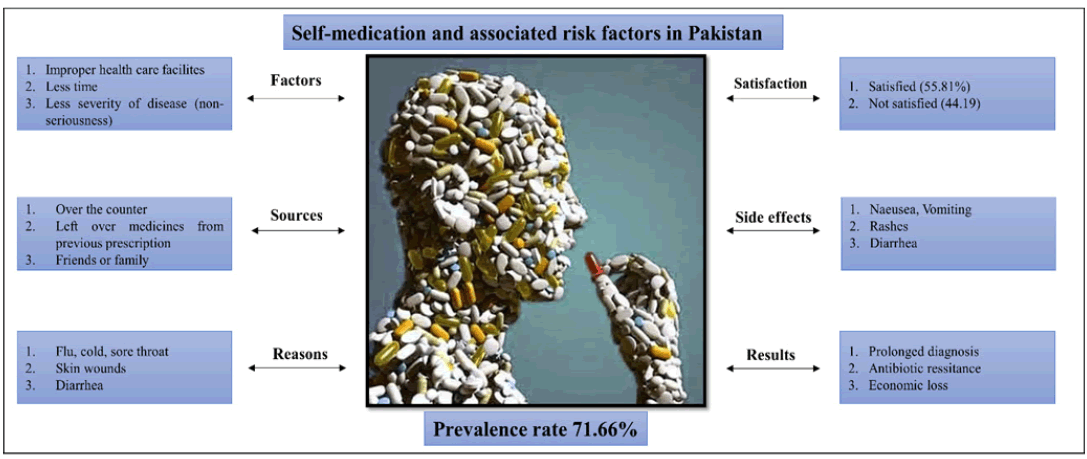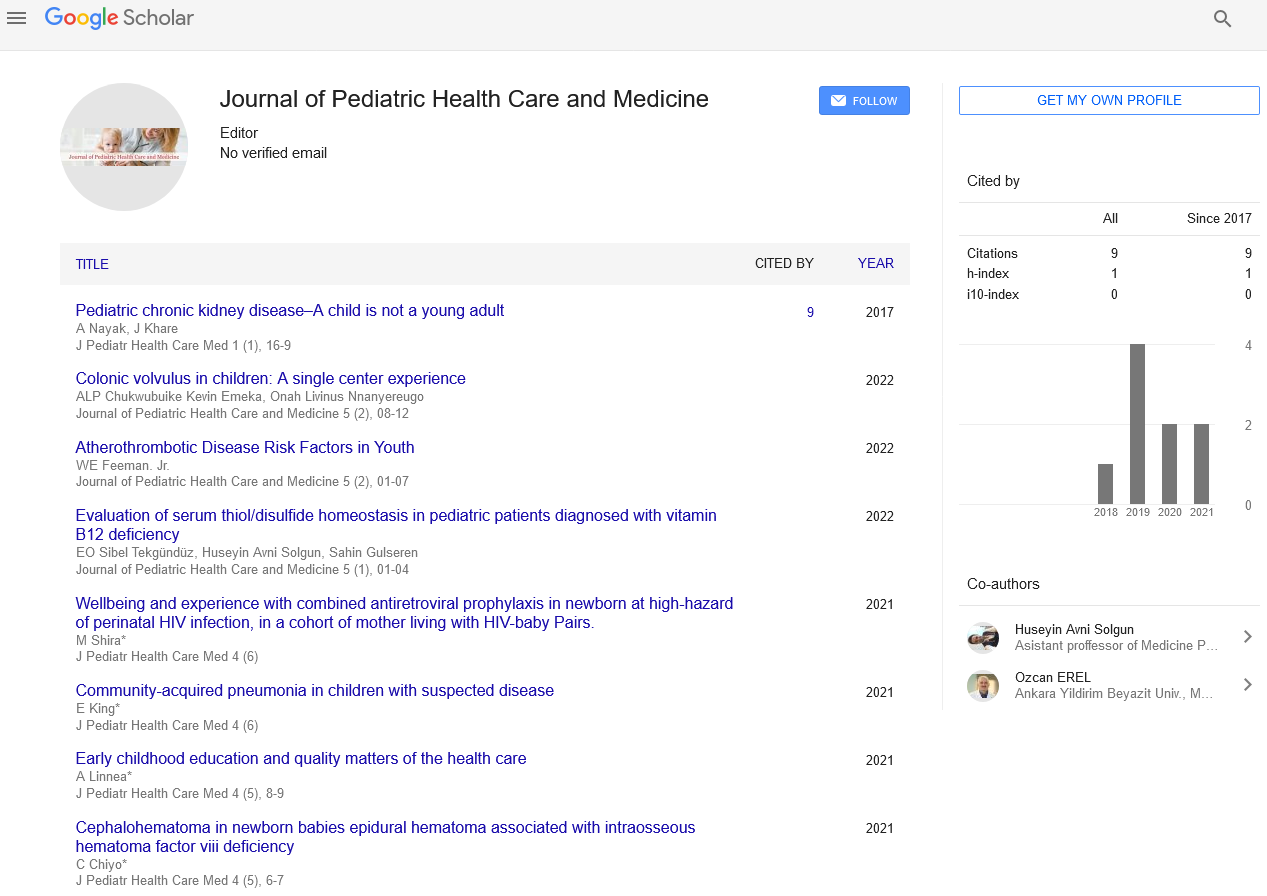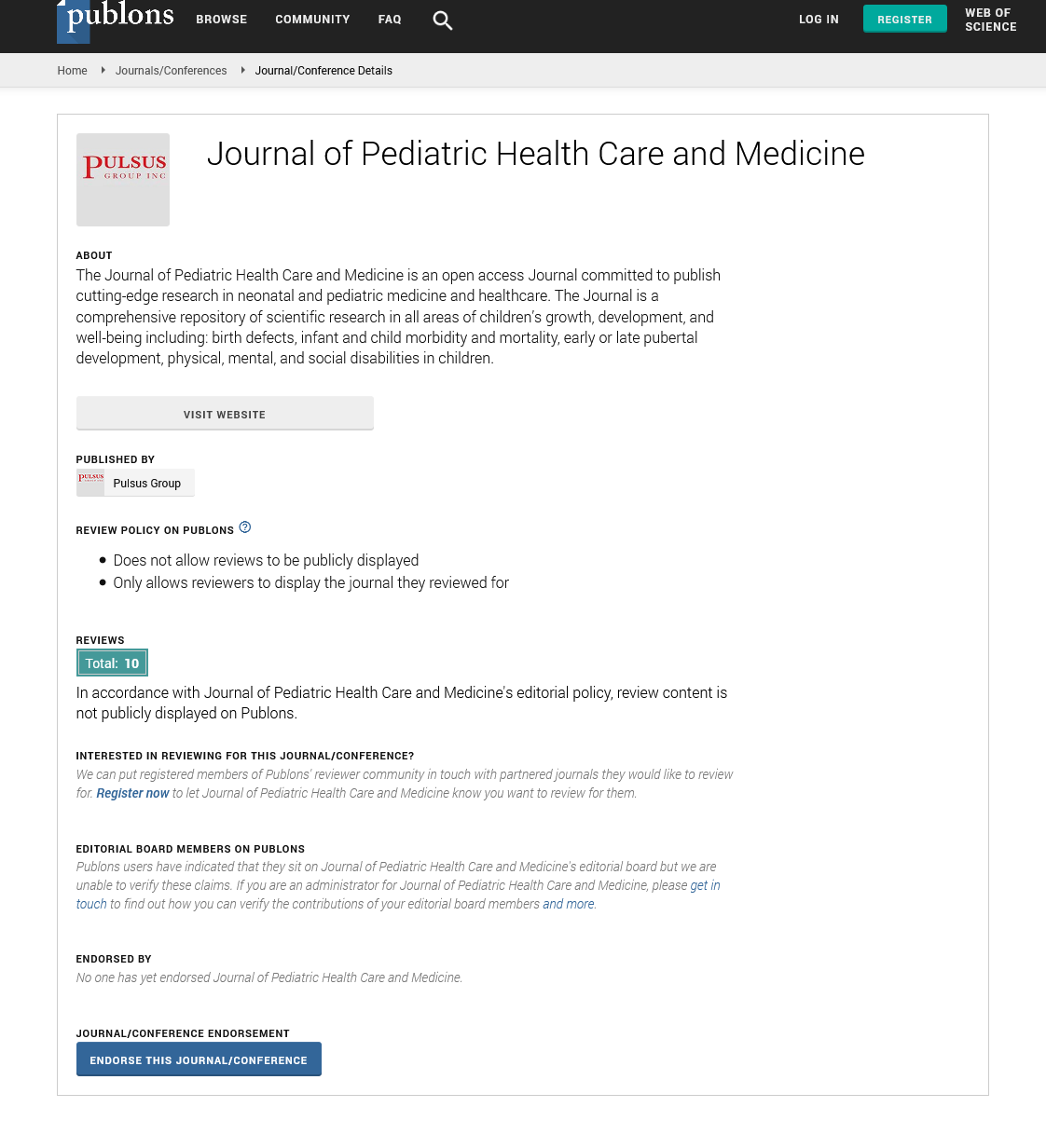Assessment of self-medication practices with antibiotics and associated risk factors among students of Hazara University Mansehra, Pakistan: a cross-sectional survey
2 Department of Microbiology, Faculty of Health Sciences, Hazara University Mansehra, KPK, Pakistan, Email: mubasherrehman08@gmail.com
3 Fuller Laboratories, 1312 East Valencia Drive, Fullerton, CA 92831, USA
Received: 02-Aug-2022, Manuscript No. PULJPHCM-22-5267; Editor assigned: 06-Aug-2022, Pre QC No. PULJPHCM-22-5267 (PQ); Accepted Date: Aug 28, 2022; Reviewed: 19-Aug-2022 QC No. PULJPHCM-22-5267 (Q); Revised: 26-Aug-2022, Manuscript No. PULJPHCM-22-5267 (R); Published: 31-Aug-2022
Citation: Munib L, Rehman M, Niaz Z, et al. Assessment of self-medication practices with antibiotics and associated risk factors among students of Hazara University Mansehra, Pakistan: a cross-sectional survey. J Pedia Health Care Med. 2022;5(4):13-15.
This open-access article is distributed under the terms of the Creative Commons Attribution Non-Commercial License (CC BY-NC) (http://creativecommons.org/licenses/by-nc/4.0/), which permits reuse, distribution and reproduction of the article, provided that the original work is properly cited and the reuse is restricted to noncommercial purposes. For commercial reuse, contact reprints@pulsus.com
Abstract
Background: Self-medication is defined as the use of drug without the prescription of medical specialists. Inappropriate use of medication may result in a prolonged diagnosis, antibiotic resistance and economic losses. This study was aimed to assess the prevalence rate and risk factors associated with self-medication practices.
Methods: A total of 120 participants were randomly selected from four different departments of Hazara University Mansehra. Out of total, 56 (46.66%) were males, and 64 (53.33%) were females. The prevalence of self-medication was 71.66%. Over the counter sale (79.06%) and left-over antibiotics from previous prescriptions (23.25%) were recorded to be the two main sources of antibiotics procurement. Most common risk factors responsible for self-medication were less health care facilities, less time and less severity of diseases.
Results: Overall, most frequently used antibiotics in the form of selfmedication were amoxicillin, erythromycin, co-amoxiclav or metronidazole.
Conclusion: Thus, it is critical to implement strict legislation, provide proper health care facilities and to develop public awareness programs.
Key Words
Antibiotics; Pakistan; Prevalence; Risk factors; Self-medication
Introduction
Self-medication is the use of drug without the prescription of physician for the treatment of self-recognized illnesses or its symptoms and is a key element of self-care Continuous increase in self-medication has become a major health care issue worldwide, especially in developing countries like Pakistan, India etc. Self-medication is considered as a root cause of antibiotic resistance [1, 2]. In developing countries where health care facilities are not proper, self-medication plays an important role in treating minor complications [3]. But if self-medicated person does not have knowledge about drug usage, it can impose serious health issues including antibiotic resistance, resource wastage, adverse drug reactions and delay in diagnosis [4].
Worldwide, numerous studies conducted on the assessment of prevalence rate of self-medication have documented its increase at alarming rate [5-8]. In under developed countries where drugs regulations are not strict, the prevalence rate of self-medication is found to be very high. In different global regions, prevalence rate of self-medication ranges between 12.7% to 95% while in Pakistan, ranges between 47.6% to 95% [6-8]. Drugs which are anti-inflammatory, antipyretics, anti-histamine, nutritional supplements and vitamins were commonly used group of drugs for self-medication purposes [4,6]. Factors that are associated with practice of self-medication include socio-demographic characters, level of education, saving time and money and limited availability of health care facilities [6,7].
To the best of our knowledge, only few studies were conducted in Pakistan to determine the prevalence rate and associated risk factors with self medications. It is necessary to conduct such kind of studies so that policy makers can make strict policies and implement rules and regulations on time. Therefore, the main aim of this study was to evaluate the prevalence rate of self-medication with antibiotics among the students at Hazara university Mansehra in Pakistan, and to determine the various risk factors associated with self-medication practices.
Materials and Methods
This cross-sectional descriptive survey was carried out in four different departments (Microbiology, Biochemistry, Genetics and Bioinformatics departments) of Hazara University Mansehra during January 02 – January 15, 2020. Study was reviewed and approved by the departmental ethical committee. Questionnaire was discussed with participants and their consent was taken. The questionnaire has two sections; questions related to demographic characteristics as well as those related to self-medication, sources, and risk factors responsible for self-medication. Data was analyzed using SPSS (v25) by calculating frequencies and percentages. All of the four-department undergraduate and graduate students who were in second last or last year (BS and MPhil students) of study and aged ≥ 18 years were part of this survey while all other students who were not enrolled in these departments and first year students were excluded.
Results
Total number of participants were 120, among which 56 (46.66%) were male and 64 (53.33%) were female with standard deviation of 0.501 and variance of 0.251. 88 (73.33%) participants were in between age of 18-25 years while 32 (26.66%) were above 25 years with 0.444 standard deviation and 0.197 variance. The brief description of participant’s demographic characteristics is shown in Table 1.
TABLE 1 Demographic characteristics of the participants (n=120).
| Variable | Parameter | Frequency | Percentage (%) | Std. deviation | variance |
|---|---|---|---|---|---|
| Gender | Male | 56 | 46.66 | ||
| Female | 64 | 53.33 | 0.501 | 0.251 | |
| Age | 18-25 years | 88 | 73.33 | ||
| ≥ 25 years | 32 | 26.66 | 0.444 | 0.197 | |
| 3rd year | 54 | 45 | |||
| Academic year | 4th year | 66 | 55 | 0.499 | 0.249 |
Based on student’s opinions, the most suitable conditions for selfmedication include, common cold, sore throat and fever (83.72%), skin wounds (16.27%) and diarrhea (13.95%). Among all participants 55.81% were satisfied as their symptoms subsided after self-medication. The most common risk factors were less health care facilities, less time and less severity of diseases.
The prevalence of self-medication with antibiotics was found to be 71.66%. The reported risk factors of self-mediation were “less severity of disease (46.51%)” followed by “saving time & money (32.55%)” and access to health care facilities (6.97%)”. The main source of self-medication was “Over the counter (OTC) availability (79.06%)” followed by “left over antibiotic from previous prescription (23.25%)” and then “left over antibiotics from friends or family members (4.65%)”. Majority of the students (93.33%) were aware of the term antibiotics.
Among all self-medicated students, 48.83% of the participants always checked the instruction of use inside the leaflets before use, while 41.86% students sometimes checked and 4.65% never checked. About 48.83% of the participants consulted the pharmacist, 39.53% checked the package insert and 11.62% consulted their family member for the dosage of the antibiotics. Among all, 69.76% participants changed the dose of antibiotic during treatment and 44.18% experienced side effect among which nausea and vomiting (69.76%), rashes (53.48%) and diarrhea (39.53%) were most frequently observed. Most frequently used antibiotics for self-medication were amoxicillin (39.53%), erythromycin (23.25%) and co-amoxiclav or metronidazole (13.95%). The data obtained via questionnaire is shown in Table 2.
TABLE 2 Shows the self- medication behavior details among Hazara University students
| Parameter | Frequency | Percentage (%) | |
|---|---|---|---|
| Self-medication prevalence | Yes | 86 | 71.66 |
| No | 34 | 28.33 | |
| Factors responsible for self-medication | Flu, cold sore throat and fever | 72 | 83.72 |
| Skin wounds | 14 | 16.27 | |
| Diarrhea | 12 | 13.95 | |
| Risk factors | Less severity of disease | 40 | 46.51 |
| Save time & money | 28 | 32.55 | |
| Said by an individual previously suffer from same illness | 12 | 13.95 | |
| less/improper health care facilities | 6 | 6.97 | |
| Antibiotic taken as self-medication | Amoxicillin | 34 | 39.53 |
| Erythromycin | 20 | 23.25 | |
| Co-amoxiclav or Metronidazole | 17 | 19.76 | |
| Others* | 15 | 17.44 | |
| Source of procurement of antibiotic | Community pharmacy counter | 68 | 79.06 |
| Left over antibiotic from previous prescription | 20 | 23.25 | |
| Left over antibiotics from friends or family members | 4 | 4.65 | |
| Checking the instruction of use inside the leaflets before use | Yes always | 42 | 48.83 |
| Yes sometimes | 36 | 41.86 | |
| Never | 4 | 4.65 | |
| Decision on the dose of antibiotic for self-medication | By consulting a pharmacist | 70 | 81.39 |
| By checking the package insert | 34 | 39.53 | |
| By consulting family members | 10 | 11.62 | |
| From the internet | 6 | 6.97 | |
| Have you ever changed the dose of antibiotic during the course of self-treatment? | Yes sometimes | 60 | 69.76 |
| Never | 26 | 30.23 | |
| Did you ever experienced any side effect when treating yourself with antibiotics? | Yes | 38 | 44.18 |
| No | 48 | 55.81 | |
| Stopped taking antibiotics | 28 | 73.68 | |
| How did you react when you experienced such side effects? | Consulted a doctor | 10 | 26.31 |
| Were you satisfied with the results of self-medication using antibiotics? | Yes | 48 | 55.81 |
| No | 38 | 44.18 | |
| Common adverse Reactions of Antibiotics | Nausea, Vomiting | 60 | 69.76 |
| Diarrhea | 34 | 39.53 | |
| Drug Resistance | 28 | 32.55 | |
| Rash | 46 | 53.48 | |
| Broad-spectrum antibiotics are better than narrow-spectrum ones | TRUE | 60 | 69.76 |
| FALSE | 26 | 30.23 | |
| Antibiotics treat infections caused by | Bacteria | 112 | 93.33 |
| Virus | 8 | 6.66 | |
Discussion
The finding of this study shows that 71.66% of the total participants had practiced self-medication which is far greater than the reported findings from Karachi university (50.1%) and lower than the reported findings from the students of Abbottabad university (95.5%) [6, 7]. The study population and the participants who prefer herbal treatment instead of antibiotics might be responsible for variation in current finding and previous findings. Self-medication prevalence rate in coastal region of south India found to be 71% which is similar to that of our findings. Globally, the prevalence of self-medication ranged between 12.7% to 95% and this difference in results might be due to different socio-economic status, educational status, demographic characteristics, availability of drug, and health care facilities [8, 9].
Finding of this study reported that flu, cold, sore throat, and fever account for more frequent health issues which was also reported in another study [10]. Reported factors of this study because of which people prefer self-medication matches with the findings of previous studies in Pakistani Universities [6, 7]. Amoxicillin, erythromycin, co-amoxiclav or metronidazole, cephalosporin group of antibiotics, ciprofloxacin, and tetracycline reported in this study have been found to be the same in previous studies conducted among university students in Pakistan and in Saudi Arabia [6,11].
During this study, it was found that OTC sale (79.06%) is the main source of antibiotics while in Saudi Arabia antibiotics dispensed via OTC were 20% and in India 27% [12, 13].
Conclusion
It is suggested that there must be proper control over OTC sales of antibiotics. Strict legislation and availability of proper health care facilities should be provided by government especially in rural areas. It is also recommended that pharmacists and medical specialists should organize awareness programs for the public regarding proper use of medicine and their possible adverse effects, if improperly used.
Survey was not conducted on larger scale and behavioral pattern of the participants which may present some bias, so it is needed to conduct survey on larger scale so that result can be generalized country wise.
Disclaimer
None.
CONFLICT OF INTEREST
None to declare.
Funding Disclosure
None.
References
- Skliros E, Merkouris P, Papazafiropoulou A, et al. Self-medication with antibiotics in rural population in Greece: a cross-sectional multicenter study. BMC Fam Pr. 2010;11(1):1-3
- Rehman M, Ahmed S, Ahmed U, et al. An overview of self-medication: a major cause of antibiotic resistance and a threat to global public health. J Pak Med Assoc. 2021;71(3):943-9
- Chaturvedi HK, Mahanta J & Pandey A. Treatment-seeking for febrile illness in north-east India: an epidemiological study in the malaria endemic zone. Malar J. 2009;8(1):1-10
- Osemene K & Lamikanra A. A study of the prevalence of self-medication practice among university students in Southwestern Nigeria. Trop J Pharm Res. 2012;11(4):683-9
- Shafie M, Eyasu M, Muzeyin K, et al. Prevalence and determinants of self-medication practice among selected households in Addis Ababa community. PLoS One. 2018;13(3):e0194122
- Shah SJ, Ahmad H, Rehan RB, et al. Self-medication with antibiotics among non-medical university students of Karachi: a cross-sectional study. BMC Pharmacol Toxicol. 2014; 15(1):1-7
- Ullah H, Khan SA, Ali S, et al. Evaluation of self-medication amongst university students in Abbottabad, Pakistan; prevalence, attitude and causes. Acta Pol Pharm. 2013;70(5):919-22
[Google Scholar] [Cross Ref]
- Worku S. Practice of self-medication in Jimma Town. Ethiop J Health Dev. 2003;17(2):111-6
- Balamurugan E & Ganesh K. Prevalence and pattern of self medication use in coastal regions of South India. Br J Med Pr. 2011;4(3):a428
[Google Scholar] [Cross Ref]
- Abay SM & Amelo W. Assessment of self-medication practices among medical, pharmacy, and health science students in gondar university, ethiopia. J Young Pharm. 2010;2(3):306-10
- Khanam P & Haj-Ali D. Assessment of the knowledge and self-medication behaviours towards antibiotics among nursing students at King Saud Bin Abdulaziz University for Health Sciences, Al Ahsa. J Nurs Care. 2017;6(6):2-6
- Aljadhey H, Assiri GA, Mahmoud MA, et al. Self-medication in Central Saudi Arabia: Community pharmacy consumers’ perspectives. Saudi med j. 2015;36(3):328-34
- Goel D & Gupta S. Self-medication patterns among nursing students in North India. J Dent Med Sci. 2013;11(4):14-7
[Google Scholar] [Cross Ref]







